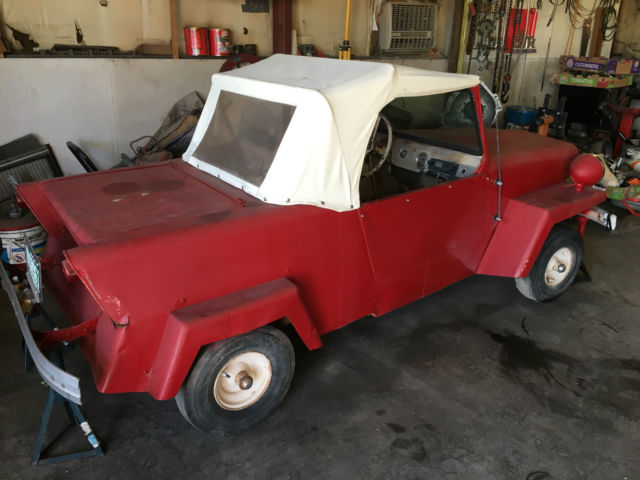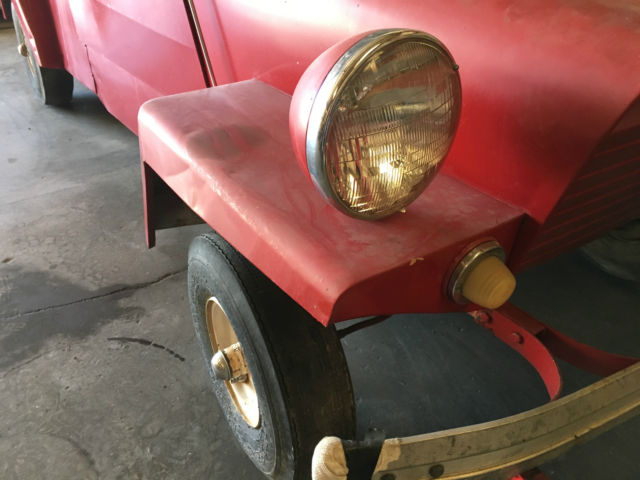1959 King Midget , MFG CO Midget Motor Company , Athens Ohio, Cushman engine
- Price:
- Make: Other Makes
- Trim: 2 door
- Year: 1959
- Mileage: 6,000
- Engine size: 180 degree opposing 2 cylinder pancake
- Number of cylinders: 2
- Drive type: RWD
- Vehicle Title: Clear
- Location: Swink, Colorado, United States
Description
UPATE: DUE TO INTEREST, I HAVE INCLUDED A VIDEO OF IT RUNNING ON YOUTUBE. I will put the video on youtube once I get the new Ebay listing number. Should be on there. Just look up 1959 King Midget.I did also have him cleanthe car up a little so you can see the paint/body better. It looks better, but would probably still look better withfresh paint. I did also include a picture of the title. However, he has not been able to locate the vin tagonthe car. I am selling this for a friend and will need to inquire with him if you have questions. You are bidding on a 1959 King Midget from the Midget Motor Corporation. It will need some restoration as you can see. The original engine was replaced with a Cushman engine. I do not know much about them, but have been told it is a 180 degree opposing 2 cylinder motor (a OMC Cushman trike motor known as a Pancake ?). It has been sitting indoor storage for awhile.It does run good but will smoke after it has run awhile and may need a rebuild.May also need some brake work, tires and 2 strutsect. This is a very unique car and not many around for sell anymore. It does have a title. Please email me with questions and I will try to get back to you as soon as I can. You will need to pick it up or make shipping arrangements.My friend may be willing to deliver it for a fee or have someone he knows deliver it as another option. Ibelieve he also saidhe as a cover that was madefor it. I will add more information as I get it. It is located in La Junta, Colorado. Not sure exact mileage.
Here is some info from the Wikipedia on the Midget Motor Corp.
King Midget was a micro car produced between 1946 and 1970 by the Midget Motors Corporation. Although the company started out by offering a kit to build the car, they soon added completely-assembled cars and later only offered completed cars. Company founders Claud Dry and Dale Orcutt first sold the King Midget as part of their Midget Motors Supply operations in Athens, Ohio. By 1948, they began to use the name Midget Motors Manufacturing Co., too. In about 1956, Dry and Orcutt changed the name of their company to Midget Motors Corporation.
Midget Motors' primary methods of advertising their cars were through small advertisements in popular magazines that appealed to home mechanics. The ads were tiny but effective; they showed a midget car and some earlier ads contained the phrase "500 lb. car for $500.00" The ads brought in a steady stream of interested customers. Some of the magazines featured articles about the car and several pictured the car on their front cover. This method of direct selling continued for most of the life of the company.
The first generation King Midget was a single-passenger kit designed to resemble a midget racer. The kit included the chassis, axles, steering assembly, springs, instruction manual, plus dimensioned patterns for the sheet metal, all for a cost of $270.00.[1] It would accept any one-cylinder engine.[1] By 1947, the Model 1 was also available in assembled form, powered by a 6hp (4.5kW) Wisconsin engine. Since adding a differential would have increased the cost, the car was driven by the right rear wheel only. It used a centrifugal clutch designed by Orcutt. The pair began to develop a two-passenger micro car in 1947. In total, nine separate prototypes were built until the designers met their goals of simplicity, lightness, and economy. The result was the Model 2.
When it first appeared on the cover of Popular Science magazine in 1951, the Model 2 was a two-passenger convertible offered either fully assembled or as a kit, powered by a 23cuin (0.4L)[1] 7.5hp (5.6kW) sidevalve[1] Wisconsin AENL engine. With a 72in (1,800mm) wheelbase (8in (200mm) less than a Crosley 4CC),[2] it measured only 102in (260cm) overall. The Model 2 was still a very basic car; it had no speedometer or reverse, but it was light, strong, and available for just $500. In 1955, a custom model of the Model 2 was introduced. It lasted through 1957, with the price remaining under $550.[1] By contrast, a four-passenger 1952 Crosley CD sedan could be had, fully assembled, for $943, and a wagon as low as $1002.[3] Soon after the Model 2 was in production, the company began to offer the option of a two-speed automatic transmission that included a reverse. This transmission, developed and patented by Orcutt and Dry, was soon to be included as standard equipment and was used on all subsequent models.
In the 1950s, Midget Motors developed the Junior and Trainer. Both designs were tube-framed motorized four-wheelers that were forerunners of the go-karts and all-terrain vehicles that were to become popular later. The Junior was powered by a 2.5hp (1.9kW) Briggs & Stratton engine, while the Trainer used a 3hp (2.2kW) Briggs and Stratton. Both had an automatic clutch with a geared, reverse transmission in the drive train. They were discontinued in the early 1960s.
In 1957, the Model 3 was introduced. On a new, 76.5in (1,940mm) wheelbase,[1] and now measuring 117in (300cm) overall, it was still smaller than a Crosley.[4] It now had four-wheel hydraulic brakes and was powered by a 9.2hp (6.9kW) Wisconsin single cylinder engine. The unit-body, which was welded for increased strength, was continued throughout to the end of production. The 1958 price approached $900.[1] (The much bigger Rambler American started at $1775.)[5] In 1966 more power was added when the company switched to a 12hp {8.9kW} Kohler engine, and also converted the car to a 12-volt electrical system. Midget production lasted through the 1960s, and eventually almost 5,000 were built.[6]
Although the founders had strictly maintained their independence, by the nineteen-sixties they were approaching retirement age. So in 1966 they accepted a buy-out offer from a group backed by investment bankers and the owners retired, but remained as consultants. Over the years they had remained profitable by carefully matching their production to sales. They had produced a unique car of their own design and constantly introduced improvements and refined their design. But the new owners had a different vision; they vastly increased production but the anticipated increased sales did not follow. By 1969, the company was forced into bankruptcy. Production manager Vernon Eads bought the remains of Midget Motors under the name Barthman Corporation. He drew up plans for a new model, the Commuter, a one-piece fiberglass car that resembled a dune buggy, but a fire at his newly built Florida plant destroyed the only body mold. The 1970 run comprised only 15 cars, including the only three Commuters ever built. The costs of rebuilding after the fire, combined with new safety and emissions standards, were more than Eads could bear, and he closed the company in 1970.[7]
 1952 KING MIDGET MODEL 2, CONVERTIBLE, 9h.p. WISCONSIN ENGINE, ALL STOCK...
1952 KING MIDGET MODEL 2, CONVERTIBLE, 9h.p. WISCONSIN ENGINE, ALL STOCK...
Mileage: 700
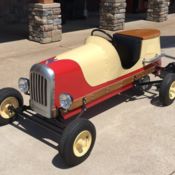 1950 KING MIDGET MODEL 1 REPRODUCTION, 5HP HONDA ENGINE, ALL BRAND NEW....
1950 KING MIDGET MODEL 1 REPRODUCTION, 5HP HONDA ENGINE, ALL BRAND NEW....
Mileage: 125
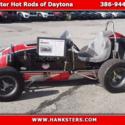 1946 Frank Kurtis Company Midget Race Car
1946 Frank Kurtis Company Midget Race Car
 King Midget Micro Car
King Midget Micro Car
 1963 KING MIDGET
1963 KING MIDGET
Mileage: 10000000
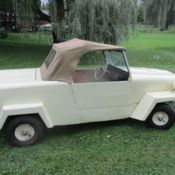 King Midget 1960 Model 3
King Midget 1960 Model 3
 King Midget 1964 in Lewisville Indiana
King Midget 1964 in Lewisville Indiana
Mileage: 5,500
 1965 King Midget Series 3 nice original car ! Cheap
1965 King Midget Series 3 nice original car ! Cheap
Mileage: 2,127
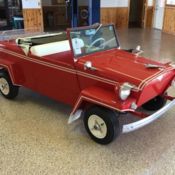 KING MIDGET MODEL 3, 20 HP KOLER V-TWIN, COMET DIFFERENTIAL.....
KING MIDGET MODEL 3, 20 HP KOLER V-TWIN, COMET DIFFERENTIAL.....
Mileage: 553
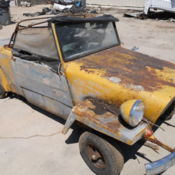 King Midget Micro PARTS CAR ONLY offered by Gas Monkey Garage with NO RESERVE
King Midget Micro PARTS CAR ONLY offered by Gas Monkey Garage with NO RESERVE
Mileage: 9,999,999

